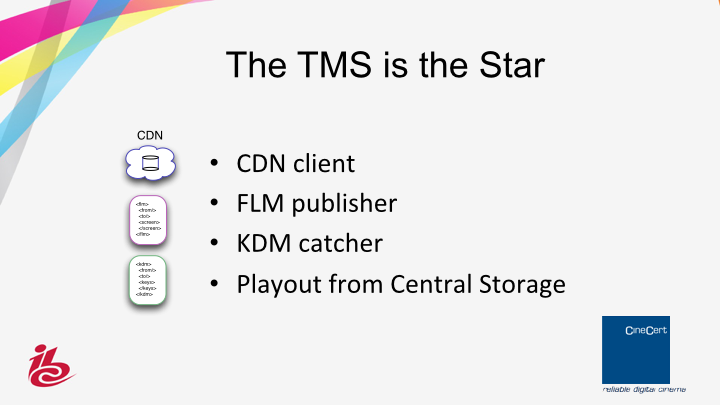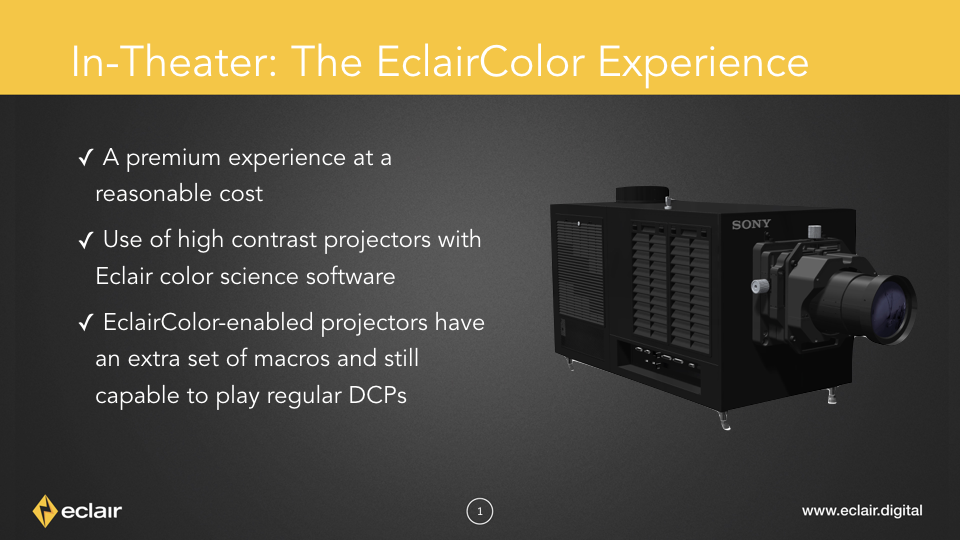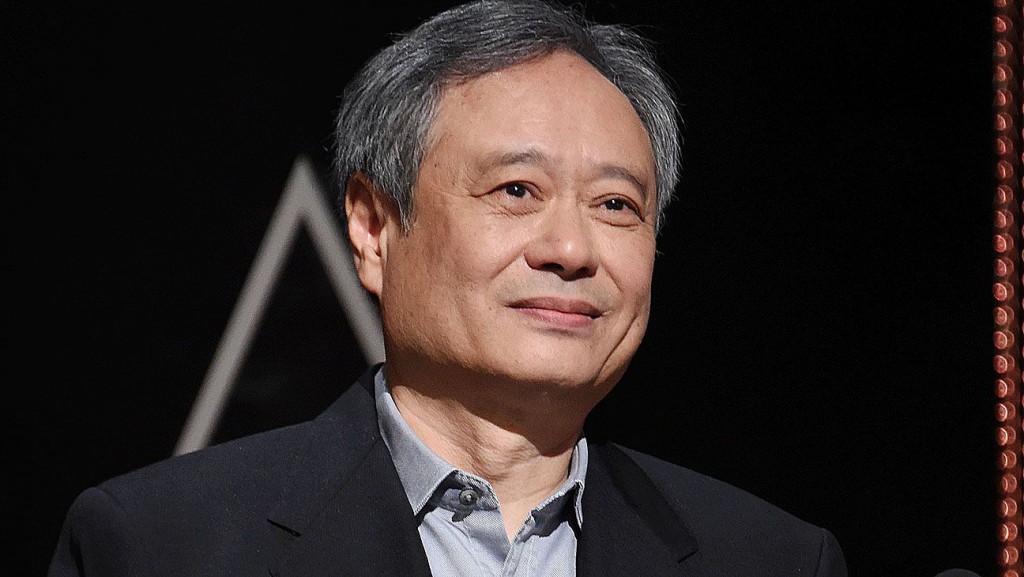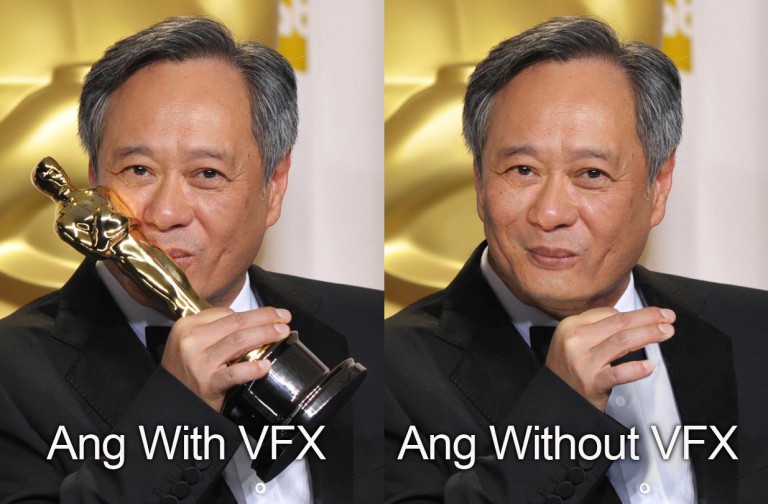(This Post-IBC article by CJ Flynn and Patrick von Sychowski was also published at Celluloid Junkie)
The event was produced by Julian Pinn as was the entire Big Screen Experience Conference track.
Celluloid Junkie’s Editor Patrick von Sychowski and regular contributor Charles ‘CJ’ Flynn were both present at IBC and discuss the impact of the screening and how the technology being demonstrated may impact the future of cinema.
CJ Flynn: One can’t consider IBC 2016 without starting and ending with reflections on the Ang Lee presentation and his thoughts and clips of “Billy Lynn’s Long Halftime Walk”.
We were given a triptych that included an on-stage interview detailing Mr. Lee’s long walk to and through the production’s desire to deliver a non-obtrusive 3D presentation, and how this drove constant unforeseen advances requiring “beyond-incremental” technology leaps.
We then saw a significant movie clip and some new technology test clips. The finish was a panel discussion titled “Realising an Auteur’s Vision: a technical deep-dive into Mr. Ang Lee’s ‘Billy Lynn’s Long Halftime Walk’” that featured the film’s editor Tim Squyres, its technical supervisor Ben Gervais and Sony Pictures Entertainment Head of Production Technology Scott Barbour who, along with Mr. Lee moved us through dozens of aspects of the ever-expanding sphere of newly exposed needs as the rough edges of the vision technology became evident.
Simply stated, needing more light showed that a 360° shutter is needed, which exposed more flicker which in turn required the highest frame rate which in turn mandated less (to the point of none) of both “standard” lighting and makeup. Unnatural shadows and even powder on the skin showed up as false and distracting in these conditions, as well as any emotion that wasn’t differently (and exceptionally) directed and portrayed by the actors.
In theory, we saw nearly the same footage and discussion at the SMPTE/NAB presentation in April. But in reality, that first presentation was in a small make-shift conference room with a screen that was too high for comfort and projectors just over our shoulders. At the time we heard Mr. Lee’s presentation before experiencing the newness of it all (or afterwards while still digesting the new and raw scenes and emotions). While this was all very striking it was somehow inartistic…un-capturable perhaps. I mean, I caught that it was exceptional in scope, but I caught only the slightest bits of the detail that made it exceptional.
In the case of IBC, from the exceptionally natural tête-à-tête flow of Julian Pinn’s introduction and questions, to the darkened auditorium with full Dolby Atmos and ultra hot-rodded Christie Mirage projectors – it was as if the 15 years of the EDCF’s IBC Digital Cinema Presentations at the RAI were all just practice for those 2 hours.
Patrick von Sychowski: Before I say anything, I should declare that as a member of the IBC Big Screen committee I could be expected to be biased in saying that this was an amazing event – but it really was an amazing event, based on my distinctly un-scientific poll of talking to people afterwards. Ninety-nine percent of people seem to have come away impressed, most of whom did not see it screened at NAB earlier this year and the sole detractors seem to just want to make a point about what they thought a “video look” was.
“Visceral” is a word that came up more than once in discussing the Ang Lee footage, because as you said, it felt very raw (and I’m not talking about the file format or unfinished edit) and direct in terms of stirring emotions. Talking to EDCF President David Hancock afterwards he said that he had a similar experience with a particularly good virtual reality “film”, so it is encouraging that cinema can find a way on the big screen to have just as hard-hitting of an emotional impact as the latest that is cropping up in VR technology.
And you’re right CJ, it was a genuinely Big Screen experience at IBC, compared to the small demo room that we were ushered into patiently waiting in groups at the SMPTE/NAB demo earlier this year. I was impressed that time, but this time it seemed more like an extraordinary cinematic event.
CJ Flynn: I didn’t get it before…at the SMPTE/NAB presentation. It seemed too wild and uncontrolled, the technology was interesting but wasted on me. There aren’t that many cones in the eye and they’re fixed on 7° of our vision, so Mr. Lee is almost giving us too much information, I thought, and he’s not telling us where to look, it’s too bright. I couldn’t put the tangents together – exploded ordinance in the mind without the expansive humanity of “Crouching Tiger” or “Life of Pi”.
What I also didn’t understand, but what was well transmitted at IBC, was that I was experiencing as an audience member what Mr. Lee was experiencing as a director – everything is coming up raw. The look in the eye as a window to the soul of the character is more broadly and granularly exposed by every ingredient of the capturing technology, every 120th of a second. So every director’s task and every cinematographer’s task and every lighting tech and gaffer’s task and every actor’s moment from prep to take – it was all raw and before those challenges were encountered as the milestones flying by, they didn’t get it any more than I did.
Then every challenge of the camera and the 7.5 terabytes of daily data and post-production with and without the Christie Mirage projectors and choosing each post technology not only for their usefulness but for their potential to expand to unknown needs, each of those flying milestones became a millstone until solved by a team of people who had to figure out then describe the problem and the team of people who had to grok it and solve it. That’s was a great story well told, in and of itself.
It was a mitigating feeling for me therefore how Mr. Lee explained how he was so constantly being lead on the journey that he had to not only locate and ride with the humility of the travel himself, but keep the crew on tempo by explaining that none of them are practiced in the specifics of this evolving craft, each of them, including himself, were “not good enough” he would say, while he tried to put into words what he often described as “humbling”.
It is a journey for us as an audience as well, and he specifically asked us to be patient as he and others in the craft walked the steps with these new tools toward better storytelling, in all their aspects. He was especially gracious to other directors and other ingredients of the technology that we have been presented with in the course of advancing the art. For example, his compelling argument that what people complained about in the high frame rate versions of “The Hobbit” as being video-like was due to their having no other category to label what they’re eyes were seeing. And as someone pointed out, it is a false category since videotape never looked that good.
Patrick von Sychowski: That leads me to the conclusion that Ang Lee is both the best and the worst ambassador possible for this new cinema technology milestone.
I’ve seen and heard James Cameron talk about new technology (primarily stereoscopic 3D) on the very same stage in Amsterdam, and boy are both filmmakers polar opposites of the spectrum. You can say a lot of things about fellow Oscar-winner Cameron, but “humble” is not a term that springs to mind. Ang Lee on the other hand doesn’t do a hard sell and sees this new technology and filmmaking methodology as a journey of discovery.
Lee is also very likely aware of the backlash against stereoscopic 3D, even though he directed what is arguably one of the greatest 3D films ever made with “Life of Pi”, not to mention the rough ride Peter Jackson faced with the 48fps HFR version of “The Hobbit”. So he is not here to tell us that “this is the future” and that we should all get onboard or find ourselves confined to the celluloid dustbin of history.
In fact, Lee was quoted in the Hollywood Reporter when he received IBC’s Honour of Excellence Award as saying, “With this movie I’m getting a new world. The use of high frame rate and high dynamic range will provide, I hope, a unique opportunity to feel the realities of war and peace through the protagonist’s eyes.” That’s about as much of a hard sell on HFR and HDR that you are ever going to get from Lee.
But if you were listening closely to Lee, particularly in the discussion with his editor, tech supervisor and head of production, you realise that there have been tremendous technical learnings that will benefit filmmakers and cinemas for a long time. For one thing, there is something happening to the human visual system when you go from 60fps to 120fps display, where suddenly the veil, window, whatever you want to call it, is removed as we see reality up on the screen. In this regard I would have loved to watch the whole clip in 2D 120fps, which is one of the versions that will be going out to cinemas.
Secondly, the various clips they showed afterwards demonstrated clearly that even if you can’t show 120fps 3D 4K in any cinema today, shooting at 120fps means that you have better images at 60fps, 48fps and even 24fps, just as we knew already that capturing 4K images and displaying them in 2K can look better than 2K projected at 2K. I will bet you anything that Cameron has changed his plans for “Avatar” 2, 3, 4, 5… to be 120fps acquisition. I just hope that the rest of the motion picture industry follows the lead into 120fps for future-proofing purposes, even though this raises the question about getting rid of makeup and lighting.
And this is even before we get into issues such as variable frame rate and its potential, such as when they discussed switching to 60fps for a pan of the cheerleaders, but staying with 120fps for the lead cheerleader to make her stand out. Will actors demand that “For Your Consideration” screenings for members of AMPAS, SAG, BAFTA, etc. be held in higher frame rate so that their non-acting acting skills can be better appreciated? Post digital conversion, is there a new technology arms race brewing in the cinema industry, with everything from 4D seating to immersive audio? There certainly seemed to be a lot of other things happening at IBC, other than just Ang Lee and “Billy Lynn”.
CJ Flynn: Well, I’m a fanboy of the technology being highlighted at IBC. I’m a Dolby Atmos fanboy – am I the only one who has thought that it is every teenage audio technologists wet dream? I’m a laser fanboy for the several reasons that range through the environmental to achieving more light for 3D and certainly, much better contrast. I’m a training fanboy for audiences and the kids who are responsible for the popcorn while also responsible for the artistic vision during those last few meters from the lens to the screen and speakers to our body’s sensors. So it is such a joy to hear and see not only Ang Lee travel the steps through the technology, but I was very impressed with the dreams and openness of the technologists during the EDCF DCinema Wrap-up.
John Hurst (CTO, Cinecert and mid-wife of digital cinema) presented a cool idea that still requires several little modules on top of the obvious but long-in-coming FLM/CDN technology which, if nudged into place could make movie theaters as immediately compelling in their programming selection as OnDemand TV.

Andy Maltz of AMPAS brought to light some HDR benefits that have arrived naturally with the now juggernaut-level of uptake for ACES. And Barco’s Tom Bert took away some of the apparent false equivalency dust that got spread by marketing and fairness – not only was his “Demystifying laser projection for cinema: 5 frequently asked questions” on target, but the show leaves one confused with numbers – so his slide stating that there are 125 Flagship RGB lasers in Cinemas, plus over a thousand of their retrofit and blue phosphor laser units in the field….this in the year following real introduction…wow.
Patrick von Sychowski: If anything the EDCF session demonstrated that if digital cinema was originally a solution in search of a problem, having been implemented, it now leaves us with even more new problems than we ever expected.
There were very honest and candid presentations about the many new technical challenges facing the industry, ranging from affordable laser projection to SMPTE DCPs, so hats of to the EDCF under its new President David Hancock (who does this in addition to his fully consuming day job at IHS) for making it an open and honest forum that matters.
Without wishing to just accentuate the negative, the EDCF day also pointed to some of the exciting developments. In addition to the ones you have already mentioned I would single out EclairColor, which I first saw demonstrated at CineEurope this summer and which is getting a major push this autumn on both sides of the Atlantic. Whatever the relative merits of EclairColor, Dolby Cinema and any other flavour of HDR, it is good to have competition and choice in imaging technologies, because that is ultimately what the cinemas are asking for.
CJ Flynn: I feel like I still don’t have the placement of the Ymagis/EclairColor technology in the big picture of things, but I did get the joy of the technology from Cedric Lejeune (Vice President of Technology – Eclair) who I have long respected for his photographic and colorist work. This concept of getting HDR onto the screen without requiring HDR to be defined only as the deservedly much vaunted million to one Dolby Vision, while not allowing it to be marketed down to milquetoast is going to be important. Customers going to premium large format rooms deserve a real definition and we need to find an absolute and communicable baseline.
 In the same but opposite manner, the angst of creating and promoting and pushing a technology through an embryonic stage was tangible as Chris Witham (Director, Emerging Technology, The Walt Disney Studios) told of the last year of SMTPE DCP transition steps and issues as the only major studio grabbing the reins and delivering features in SMPTE DCP. That was followed by Tony Glover (VP, Mastering Technology and Development, Deluxe Technicolor Digital Cinema UK) detailing the two live tests of the EDCF SMPTE DCP testing. Great data of a plan that I look forward to following as it is rolled out into larger and larger spheres.
In the same but opposite manner, the angst of creating and promoting and pushing a technology through an embryonic stage was tangible as Chris Witham (Director, Emerging Technology, The Walt Disney Studios) told of the last year of SMTPE DCP transition steps and issues as the only major studio grabbing the reins and delivering features in SMPTE DCP. That was followed by Tony Glover (VP, Mastering Technology and Development, Deluxe Technicolor Digital Cinema UK) detailing the two live tests of the EDCF SMPTE DCP testing. Great data of a plan that I look forward to following as it is rolled out into larger and larger spheres.
Also provocative were the similar presentations of Julian Pinn (CEO – Julian Pinn Ltd) and Rich Welsh (CEO – Sundog Media Toolkit) who both spoke about “watch-this-space” developments that they are now productizing to handle important nuances left behind in the rollout of digital cinema. As a developer myself, I wondered if anyone else had a problem with transmitting the emotion of a heartfelt belief when there are only words to do it with. But there they were, people with exceptional histories touching us with their passions.
Oh, and there was that guy who showed a picture of frog’s hair and thought that just because the DCPs for non-technical managers were free and include a Manager’s Walk Through Series Report checklist that he could get away with pushing his new website at www.CinemaTestTools.com. That was myself, and yes, that is a shameless plug.

And leaving the first for last, I agree with you Patrick, it was great to see what the new EDCF President, David Hancock can do with the numbers. For so long there was the driving focus of one metric – the march toward 100% saturation. Now it is an interesting group of metrics on diversification, the very things that the digital transition were supposed make cinemas more viable in an age when studios were closing distribution windows and a new audience had more choices for their time and money. The transition itself balled everything up for a long while. It will be nice to see how these numbers progress.
Patrick von Sychowski: I was hoping you would get to the regenerating hair in the frog’s ear, which enabled it to restore damaged hearing, something us humans can’t do. Your talk was definitely the talk of the talk at the drinks reception right after the EDCF session – and not just for the frog ear hairs. There were also people coming up and asking about the availability of the DCP test tools from your website, so let’s return to those in a future post.
I have also come up with the perfect analogy for the proliferation of DCP versions that currently bedevils our industry (any guesses if “Billy Lynn” will go out in fewer or more than 400 versions?). It is like an EDCF drinks party where you get a choice of red wine, white wine, water or juice from a tray, as opposed to everyone standing in line to get their custom designed cocktails made to order. Waiting in line for 10-15 minutes to get to alcohol when you’ve just sat through three hours-plus of heavy-duty tech talk was not ideal. Let’s go back to just the four options next year, because there are always plenty of other things going on at IBC.

CJ Flynn: It should also be an embarrassment for the IBC that they – with a portion of each convention area for every technology type and a sponsor everywhere, and having been the first and best with video presentations of the convention events – why aren’t they finding an IT and delivery sponsor and making the Big Screen Experience presentations live on the Internet, complete with audience interaction. Otherwise, too many of the presentations become commodities speaking to an uncompelled crowd now that the equipment has matured. There are important product differences, but the presenters have to be too very polite even with the technology, lest the fellow panelists or future client in the audience get miffed.
Patrick von Sychowski: I will half-agree with you on this one. Obviously showing “Billy Lynn” 120fps 3D 4K streamed over the internet can’t be done, even if Sony Pictures were to allow it. The same goes for other sessions where Hollywood studio material is shown on the big screen. But it would be good if the sessions that don’t use sensitive material were captured and shared, if not live, then at least TED-style at some later point. Because all of the sessions, even Ang Lee, deserved an even bigger audience than they got.
That takes me to the perennial point that the largest challenge facing the IBC Big Screen Experience is going beyond preaching to the choir and attracting more cinema people. Apart from the two representatives of Vue and Cinemax who were speaking on panels I only met one exhibitor in the audience. This was their chance to see “Billy Lynn” in a format that will shape the future of cinema, and yet despite the fact that attendance is free, they did not make the journey to Amsterdam. Nor did representatives of any cinema trade association.
I wish I knew of a good way to persuade cinema people to come to Amsterdam for IBC other than telling them that the Ang Lee presentation was an amazing eye opener. We really did watch cinema history being made in front of our eyes.
CJ Flynn: The Ang Lee keynote and the final presentation, which took an entirely different tack, were terrific and provocative. When that exceptionally talented moderator – oh, wait, that was you Patrick – when you put out the idea of having a panel of judges rate different cinema technologies like “Strictly Come Dancing” (“Dancing With the Stars” in the US), I thought, cute, but uhm…OK. But then it showed off the best sequence of the presentations.
Four different people from different slices of the business – a manufacturer, an installer, a cinema technical chief and an analyst – all got to point out reasoning that I couldn’t have imagined for justifying or nay-saying different portions of the technology spectrum as having potential return-on-investment or not. Brilliant idea, well done and I hope you take full credit for it since you’ll be remembered for the presentation. If only we in the audience could have had control of a laugh and groan track, and a dynamic rating bar.
Patrick von Sychowski: I will do an Ang Lee and say that I feel humble, not because it wasn’t a brilliant last-minute panic move to steal the format from reality TV, but because I would not have expected that of the dozen technology categories that were judged, blue phosphor laser would come out on top while VR languished in the bottom. Let’s see at next year’s IBC what the future holds. Please feel free to bring a cinema friend or two.
In the meantime I’d like to thank all the technology companies that worked with Mr. Pinn and IBC to make the Big Screen Experience day possible. I know that there is a risk in trying to list everyone as you inevitably forget someone, but Phil White’s team who coordinated everything on the tech side deserve a major shout-out, because they had to install so much equipment in the balcony of the Rai auditorium that at one point they thought it would need reinforcing. Don’t forget that there were not only the Christie twin Mirage projectors for “Billy Lynn”, but also the dual Christie/Dolby laser projector (and that’s a lot of cooling required) set-up for the screenings of Disney’s “The Junglebook” and 20th Century Fox’s “The Revenant” in Dolby Vision and with Atmos immersive audio.
I didn’t stay for the latter but I’m sure the bear mauling is even more visceral in HDR and surround-growls, while “Jungle Book” was a bright 3D delight. So Christie, Dolby, Harkness Screens, the projector and audio technicians, the studios who let IBC see the films and footage and everyone who flew to Amsterdam to share their insights. I’m sure I’ve neglected to mention plenty of others: QSC? EDCF? Ang Lee’s entourage?
CJ Flynn: Mustn’t forget Terry Nelson and partner Sean O’Dea for making the talent sound good every year while handling the live audio mixing console and other physical aspects of setting up the presentations. And thank you Patrick for this conversation. À la prochaine fois.


